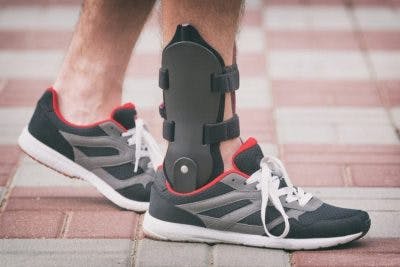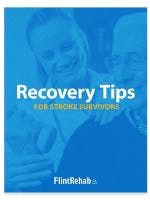While great, these are all guidelines NOT PROTOCOLS. Notice that NOTHING IS YOUR DOCTOR'S RESPONSIBILITY. You are completely on your own, hope you enjoy your medical responsibility for your recovery, your doctor blew it by doing nothing in the first week during the neuronal cascade of death and letting billions of neurons die. I only lost 5.4 billion neurons that first week. If I had only lost 177 million neurons in the first 90 minutes until I got tPA I would be fully recovered by now.
How to Recover from Stroke Quickly with 11 Helpful Tips: from Flint Rehab
On the road to recovery, it can be tempting to look for methods on how to recover from stroke quickly. Fortunately, there are ways to maximize your potential; but it’s also important to acknowledge that there are no quick fixes for healing the brain.
Every stroke is different, and every recovery is different as a result.(Excuses, excuses!) This means that all patients recover at different rates, based on their own unique factors.
Fortunately, there are tips that can help you improve the effectiveness and efficiency of your recovery. This post will provide insight into those tips.
Using Neuroplasticity to Recover from Stroke Quickly
Did you know that the brain can bounce back from injury and heal itself after a stroke? This process is called neuroplasticity.(But no one can tell you EXACTLY how to do it. You'll get guidelines, NOT PROTOCOLS!)
Neuroplasticity allows the brain to reorganize and rewire itself to be as efficient as possible. After a stroke has damaged parts of the brain, neuroplasticity encourages healthy areas of the brain to pick up the slack.
However, in order to encourage recovery, the brain needs constant stimulation. When you repeat a thought or task on a regular basis, the brain attempts to become more efficient at that thought or task.
Stimulate neuroplasticity by focusing on activities that stimulate and rewire your brain. This post contains 11 helpful tips on how to this.
Before we dive in, we’d like to add a note on “snake oil salesmen.”
Be very careful if someone promises you fast results during stroke
recovery.(But you just did!)
Some common fallacies are magnesium oil and Etanercept. Both remedies promise fast results but there is poor clinical evidence behind them.
The brain heals itself through incremental changes. As long as you’re putting in the work on a consistent basis, you can maximize your chances of recovery — and recover as quickly as possible.
How to Recover from Stroke Quickly
Now that you understand the basics of how stroke recovery works, let’s dig into the tips that can speed up the process:
1. Focus Your Attention on the Most Important Thing…
Quick tip: Stimulation and repetitive practice are essential for recovery.
Repetition is a critical ingredient during recovery from stroke. Repetition activates neuroplasticity, your brain’s mechanism for rewiring itself and creating efficiency. This is how you can rebuild your skills and overcome the side effects of a stroke.
During inpatient therapy, you will spend many hours each day practicing various exercises to rebuild lost skills. This helps activate neuroplasticity and improve your ability to perform daily activities.
For instance, practicing leg exercises can improve your ability to walk after a stroke.
Practicing these skills on a daily basis will promote a faster recovery and provide the stimulation your brain needs to recover.
2. Get Better at Walking by Focusing on More Than Your Feet
Quick tip: Improving your gait (ability to walk) is a full-body task.
If you struggle with walking after stroke, your physical therapist can help you recover by showing you which exercises to practice.
(S)he may recommend different exercises for your legs, feet, and core. Be sure to practice exercises for the full-body, because walking is a full-body task.
If you struggle with consistency, consider using a home exercise program like FitMi home therapy. It tracks your progress and encourages high repetition of full-body exercises to help you reach your goals.
3. Don’t Slow Down Your Foot Drop Recovery with AFOs
Quick tip: AFOs are important for safety, but don’t forget to exercise too.

AFO braces (ankle foot orthotics) for foot drop help improve your gait if you have difficulty lifting the your foot up (also known as dorsiflexion).
These braces are essential for preventing falls as you move about your daily life. If you struggle with foot drop, be sure to ask your therapist for help.
It’s also important to know that AFO braces are a compensation technique. This means that they help you adapt to disability but do not necessarily promote recovery.
This does not mean you should skip wearing your AFO. Instead, practice foot drop exercises on a daily basis to enhance your recovery. In doing so, you are reducing the risk of learned non-use.
4. Use Inexpensive Apps to Improve Speech After Stroke
Quick tip: Speech therapy apps are a great way to improve speech at home.
If you had a left-brain stroke, you may have language difficulties like aphasia. A speech therapist (called a Speech-Language Pathologist) can diagnose your specific type of aphasia and guide you through recovery.
However, attending speech therapy once per week does not necessarily provide enough stimulation for the brain to induce neuroplasticity. If you want to recover from stroke quickly, you need to stay engaged in therapy at home, too. This is where speech therapy apps can help.
Apps are available straight from your phone or tablet any time you need them. You don’t need to wait to see your therapist to keep your brain engaged in therapy. Best of all, you can ask your therapist to assign exercises that suit your needs.
5. Bounce Back from the Dreaded Plateau
Quick tip: The stroke recovery plateau is a well-documented phenomenon, but it does not mean that recovery is over!
Stroke recovery tends to slows down around the 3 month mark. This “plateau” often causes patients to be discharged from inpatient therapy, and it does not mean that it’s the end of the road.
In fact, it’s a sign to remain consistent with your home exercise program in order to keep recovery going. Without inpatient rehab to keep you engaged, it becomes more important to stick with a daily rehab regimen at home to recover from stroke as quickly as possible.
6. Reverse Regressions Quickly by Staying Consistent
Quick tip: It’s common to take two steps forward and one step back.
It is common to experience a regression in recovery. However, you should always talk with your doctor or therapist as a regression can indicate other complications.
If you feel like you took two steps forward and one step back, it can help to look at your progress during previous week. Did you exert yourself more than usual?
Again, be sure to check in with your therapist or doctor. You may find that a small regression (one step back) is followed by another phase of recovery (two steps forward).
7. Speed Up Recovery from Stroke with Meditation
Quick tip: Meditation is an underrated practice that can help accelerate recovery from stroke.
Do you know about the power of meditation for stroke recovery? At first glance, it might seem too simple to help. But when you look at the clinical studies, you’ll see that meditation provides great benefit for stroke survivors.
Meditation can be an uncomfortable experience if you are accustomed to a busy schedule. But don’t let uncertainty keep you from reaping benefits of this brain-nourishing practice.
8. Recover from Stroke Quickly with a Healthy Diet
Quick tip: You can boost neurogenesis with specific healthy foods

Neurogenesis is the creation of new neurons in the brain — something that could boost your efforts of recovering from stroke as quickly as possible.
Some of the best foods for stroke recovery are ones that promote neurogenesis. Examples include fish, pomegranate, nuts, seeds, and blueberries.
If you struggle with diet-related stroke risk factors, such as high cholesterol or obesity, talk to your doctor before making any new dietary changes.
9. Get Adequate Sleep
Quick tip: It’s common to sleep more than usual after a stroke as the brain is recovering.
Many stroke survivors can be startled or surprised by how much sleep they crave after stroke. If you find yourself sleeping excessively during recovery, it’s probably a good sign.
Sleep helps improve movement recovery after stroke by turning the short-term memories from the day into long-term memories. It also gives the brain time to rest and recharge.
If you are worried about how much you are sleeping, or if insomnia is preventing you from getting enough sleep, talk to your doctor.
10. Be Intentional with Your Rehab Regimen
Quick tip: Consistency is key if you want to recover from stroke quickly.
As we mentioned previously: neuroplasticity is the key to recovery after stroke. And your brain requires consistent stimulation in order to rewire itself.
For this reason, inconsistent participation in rehab won’t lead to the best results due to lack of repetition. In order to recover as quickly as possible, you need to participate in therapy consistently.
If you struggle with staying motivated at home, try investing in a home exercise program that’s more interactive, such as Flint Rehab’s FitMi home therapy.
11. Strive for a Full Recovery
Quick tip: “Shoot for the moon. Even if you miss, you’ll land among the stars.”
Not all stroke survivors can achieve a full recovery — however, many stroke survivors are told limiting beliefs about recovery, and yet they go on to achieve remarkable results.
What would happen if those individuals stopped rehab once they reached the limit imposed on them? They wouldn’t recover, because they stopped rehab.
For this reason, the team at Flint Rehab believes that everyone should strive for a full recovery from stroke.(But only 10% fully recover. You sound like a snake oil salesman.)
Believing that a full recovery is possible will motivate you to take more action, which will naturally lead to more results. Even if you don’t get there 100%, you’ll get much farther than believing otherwise.
If you need help staying motivated, try reading successful stroke recovery stories from other survivors in similar shoes.
You can be one of those success stories if you follow all of these steps! We wish you the best of luck on the road to recovery.

No comments:
Post a Comment